As we approach 2024, the focus on incorporating fresh and innovative ideas into interior design is more important than ever, with fireplaces emerging as a key focal point in living spaces. This year, the trends in fireplace designs are evolving beyond just warmth and comfort; they’re about making bold statements, embracing functionality, and aligning with environmental consciousness.
In this article, we’ll explore the latest trends in fireplace designs for 2024, highlighting how these trends cater to the diverse aesthetic and practical needs of interior designers. From eco-friendly options to smart, technologically advanced designs, these trends are reshaping the way we think about fireplaces in modern interiors.
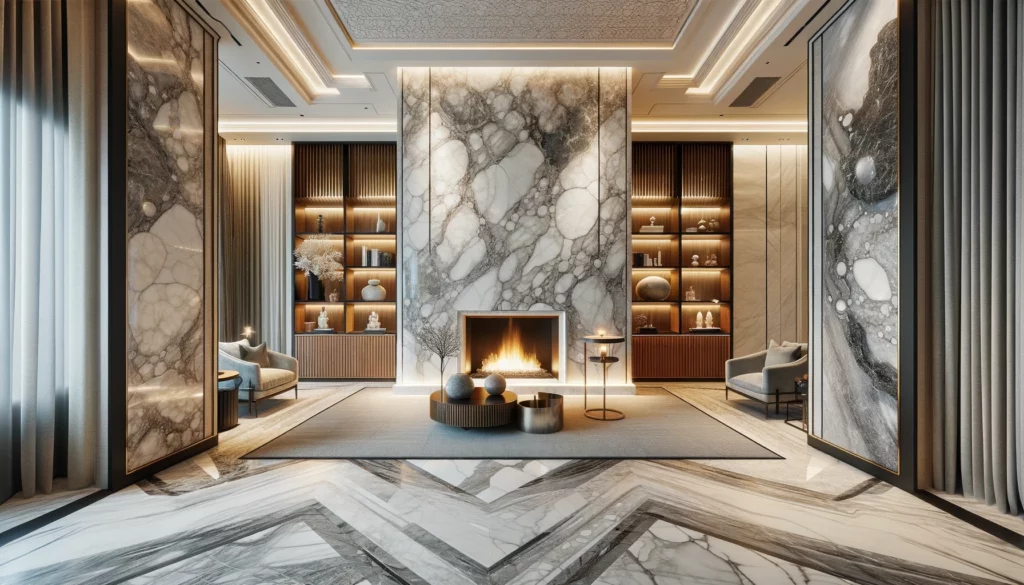
Making a Bold Statement with Natural Stones
The resurgence of natural stones like marble, slate, and granite in fireplace designs marks a significant shift in interior aesthetics. These materials, revered for their timeless beauty and robustness, are now being leveraged to transform fireplaces into stunning centerpieces that command attention and exude luxury.
Why Natural Stones?
Natural stones bring an element of the outdoors inside, creating a connection with nature that’s both grounding and elegant. Their distinct patterns and textures offer a tactile and visual richness unmatched by artificial materials, making each fireplace uniquely captivating. Moreover, the durability and heat resistance of these stones ensure that they not only look spectacular but also stand the test of time and function efficiently as part of a fireplace.
Another advantage of natural stones is their versatility in design. They can seamlessly fit into various interior styles, from rustic country homes to sleek, modern apartments. This adaptability makes them a favorite among designers looking to create a bespoke look that resonates with the individuality of each space.
What Stones are Popular?
Marble, with its refined veining and luxurious feel, has become a particularly popular choice for high-end designs. Its ability to reflect light enhances the brightness and spaciousness of a room. Slate, on the other hand, offers a more understated elegance with its muted tones and subtle texture, making it ideal for contemporary spaces. Granite, known for its durability and wide range of colors, brings a touch of sophistication and solidity to fireplace designs.
Each stone has its unique character. Marble is often associated with opulence, slate with modern minimalism, and granite with a classic, enduring appeal. This diversity allows designers to pick a stone that not only complements the interior décor but also aligns with the client’s personal style and preferences.
Tips on Selecting the Right Stone
When selecting a stone, consider the overall color palette and lighting of the room. Lighter stones like white or beige marble can make a space feel more open and airy, while darker stones like black granite add depth and drama. The lighting in the room will also affect how the stone’s color and texture are perceived, so it’s important to consider the natural and artificial light sources.
Another consideration is the maintenance and care of the stone. While granite is relatively low-maintenance, marble requires more care to prevent staining and etching. Understanding the client’s lifestyle and willingness to maintain the stone is crucial in making a selection that suits their needs and preferences.
Innovative Applications
Beyond traditional fireplace surrounds, natural stones are now being used in more creative and expansive ways. Extending the stone from the fireplace up to the ceiling creates a stunning visual column that can make the room appear taller and more grand. Incorporating the stone into adjacent walls or shelving units can also create a cohesive and immersive design.
Designers are also experimenting with mixing materials. Combining natural stone with elements like wood, metal, or glass introduces texture contrast and adds an extra layer of sophistication to the design. For instance, a marble fireplace surround paired with a sleek glass mantel or a slate fireplace accented with warm wood details can create a striking balance between different materials.
These innovative applications of natural stone in fireplace designs allow interior designers to push boundaries and create spaces that are not only aesthetically pleasing but also reflective of their clients’ personalities and lifestyles.
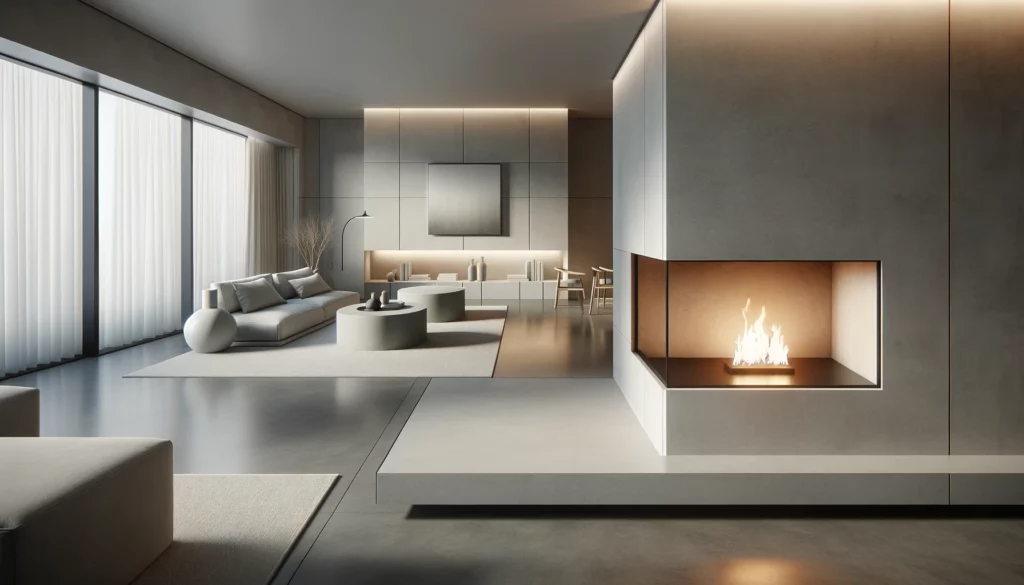
Minimalistic Fireplaces: The Elegance of Simplicity
The minimalist design philosophy in fireplaces emphasizes clean lines, uncluttered aesthetics, and functional simplicity. This trend aligns perfectly with modern interior design sensibilities, offering a sleek and understated elegance.
The Appeal of Minimalism
Minimalism in fireplace design is about creating a space that feels open, serene, and uncluttered. This style is characterized by its straightforwardness and emphasis on the bare essentials. The appeal lies in its ability to create a calm and peaceful ambiance, making the fireplace an oasis of tranquility in the home. These designs often use neutral colors and simple materials, focusing on the purity of form and space.
Minimalist fireplaces are not just about aesthetics; they are also about functionality. The simplicity of the design often enhances the efficiency of the fireplace, making it easier to use and maintain. This practical aspect is particularly appealing in today’s fast-paced world, where convenience and ease of use are highly valued.
Popular Features in Minimalist Fireplace Designs
A key feature in minimalist fireplace designs is the use of geometric shapes and clean lines. Rectangular or square fireplaces with a smooth, flat surface are common, offering a crisp and modern look. The absence of ornate details or complex patterns is intentional, directing focus on the elemental beauty of the fire itself.
Materials play a crucial role in minimalist designs. Polished concrete, smooth stone, or metal are popular choices, offering a sleek and contemporary look while being durable and easy to maintain. The use of glass is also prevalent, either as a protective screen or integrated into the design, adding a light and airy feel.
Choosing the Right Materials and Colors
When selecting materials for a minimalist fireplace, consider the texture and finish. Matte or satin finishes on stone or metal can create a subtle, sophisticated look, while polished surfaces can add a touch of modern glamour. The choice of material should complement the overall design theme of the room.
Color selection is equally important in minimalist designs. Neutral colors like white, black, gray, and beige are popular as they create a serene backdrop for the vibrant flames. These colors also allow for easy integration into various color schemes, ensuring the fireplace complements the room’s decor.
Innovative Design Techniques
One innovative approach in minimalist fireplace design is the integration of the fireplace into the wall, creating a seamless look. This technique not only saves space but also enhances the minimalist aesthetic. Another trend is the floating fireplace, where the fireplace is mounted off the ground, creating a sense of lightness and modernity.
Designers are also exploring the use of asymmetry in minimalist fireplace designs. An off-center fireplace or an irregular geometric shape can add a unique, contemporary twist to the space, challenging traditional design norms while maintaining a minimalist ethos.
Minimalist fireplace designs offer a perfect blend of form and function, providing a modern and uncluttered focal point in interior spaces. By focusing on simplicity, designers can create fireplaces that are not only aesthetically pleasing but also efficient and adaptable to various interior styles.

Brightening Spaces with Colorful Fireplace Surrounds
The introduction of vivid colors in fireplace design is a bold departure from traditional styles, infusing living spaces with energy and personality. This trend, will become more prominent in 2024, and encourages the use of striking hues to transform the fireplace into a standout feature.
The Power of Color in Fireplace Design
The use of color in fireplace surrounds offers a dynamic way to inject character into a room. Bright and bold colors can turn the fireplace into an art piece, drawing the eye and becoming a conversation starter. This trend reflects a broader movement in interior design towards more expressive and individualized spaces. Vivid colors can evoke emotions, from the warmth of a sunny yellow to the calm of a deep blue, adding a new layer of sensory experience to the room.
In contrast to the neutral tones traditionally used in fireplaces, these colorful designs are about making a statement. They challenge the norms and offer an opportunity for designers and homeowners to showcase their creativity and personal style.
Popular Color Trends in Fireplace Surrounds
The color trends in fireplace surrounds vary widely, offering something for every taste and style. Bright, saturated hues like teal, crimson, or emerald are popular for creating a bold and dramatic effect. These colors work well in larger spaces or rooms with ample natural light, as they can dominate smaller, darker areas.
For a more subtle approach, pastel shades such as blush pink, soft lavender, or mint green offer a gentle pop of color. These hues are ideal for creating a soothing and inviting atmosphere, especially in bedrooms or reading nooks.
Tips on Selecting and Integrating Colors
When selecting a color for the fireplace surround, consider the existing color palette of the room. The fireplace color should complement, not clash with, the other hues in the space. It’s also important to think about the mood you want to create – vibrant colors can energize a room, while softer tones can create a more relaxed environment.
Another consideration is the material of the surround. Painted wood or plaster can easily take on any color, allowing for more flexibility and experimentation. Tiles, whether ceramic or glass, offer a different texture and can add depth and interest to the fireplace design.
Innovative Use of Color in Fireplace Design
Beyond solid colors, designers are exploring patterns and gradients in fireplace surrounds. A gradient effect, transitioning from one color to another, can create a striking and contemporary look. Geometric patterns or murals are other ways to introduce color while adding a unique artistic element to the design.
Another trend is the use of contrasting colors. For example, a dark-colored fireplace in a light-colored room, or vice versa, can create a dramatic contrast that enhances both the fireplace and the surrounding space.
Colorful fireplace surrounds are a testament to the evolving nature of interior design, where function and form merge with personal expression. By embracing color, designers can create fireplaces that are not just sources of warmth but also vibrant centerpieces that reflect the personalities and tastes of their clients.
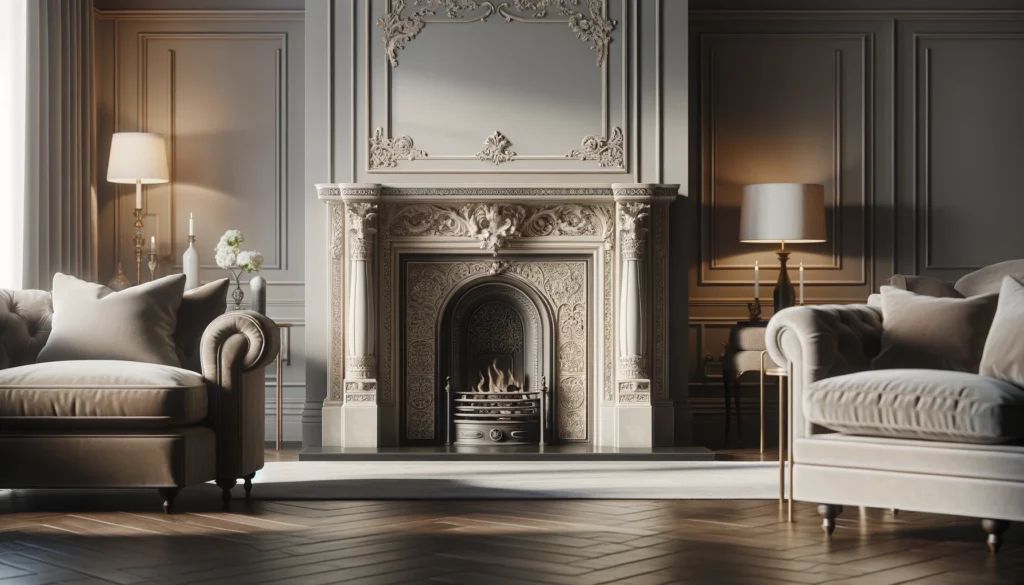
Vintage Fireplaces: A Nod to the Past
The resurgence of vintage and retro designs in fireplace aesthetics marks a delightful blend of nostalgia and elegance. As we navigate to 2024, the charm of vintage styles in fireplaces is being rediscovered, offering a timeless appeal that complements a variety of interior decors.
The Charm of Vintage Design
Vintage fireplaces are characterized by their intricate details, classic forms, and rich historical undertones. They evoke a sense of history and craftsmanship that’s often lacking in modern, mass-produced designs. The allure of these fireplaces lies in their ability to add a layer of sophistication and warmth to a space, creating a cozy, inviting atmosphere reminiscent of a bygone era.
These designs often feature ornate carvings, elegant curves, and traditional materials like cast iron or intricately patterned tiles. They are not just functional elements but also artistic pieces, each with a story to tell.
Popular Vintage Fireplace Styles
Among the most sought-after vintage styles are those from the Victorian and Edwardian eras, known for their grandeur and ornate detailing. Victorian fireplaces often showcase elaborate scrollwork and decorative motifs, while Edwardian designs are slightly more restrained, with a focus on symmetry and lighter colors.
Art Deco fireplaces are another popular choice, known for their geometric patterns and bold, streamlined forms. These fireplaces capture the essence of the early 20th century with a sense of glamour and luxury.
Selecting and Integrating Vintage Fireplaces
When integrating a vintage fireplace into a modern space, it’s essential to balance the old with the new. The fireplace should complement the room’s overall style without overwhelming it. In a contemporary setting, a vintage fireplace can serve as an eye-catching focal point, while in a more traditional decor, it can enhance the room’s historic character.
It’s also important to consider the size and scale of the fireplace. Vintage fireplaces can be quite large and imposing, so they’re best suited to rooms with ample space and high ceilings.
Preserving and Adapting Vintage Designs
One of the challenges with vintage fireplaces is ensuring they are functional and safe by modern standards. This may involve restoring or adapting the fireplace, such as installing a new firebox or flue system. It’s crucial to work with specialists who understand how to preserve the historical integrity of these pieces while making them suitable for contemporary use.
In cases where an authentic vintage fireplace isn’t feasible, reproductions or modern fireplaces inspired by vintage designs can be excellent alternatives. These offer the aesthetic appeal of vintage styles but are built to current safety standards and can be more easily integrated into a variety of spaces.
The revival of vintage fireplace designs is a testament to the enduring appeal of classic aesthetics. These fireplaces offer a unique way to infuse character and history into a space, creating a warm and inviting ambiance that transcends trends and time.
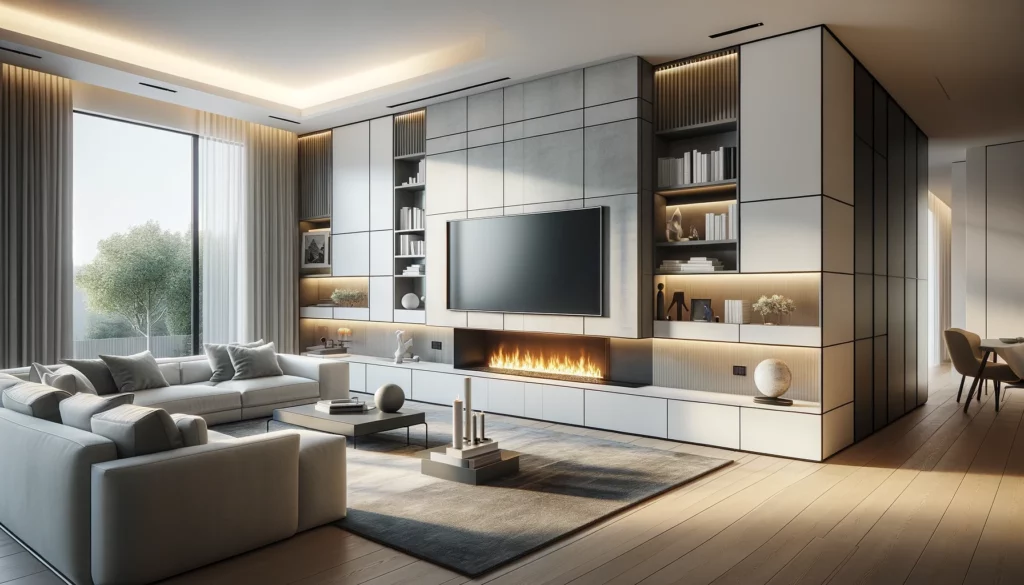
Dual-Functionality: Fireplaces as Space Savers
The trend of multifunctional design in fireplaces is a response to the growing need for space efficiency in modern living environments. As we approach 2024, fireplaces are not just being designed for warmth and aesthetics but also as smart solutions to space constraints, combining functionality with style.
The Rise of Multifunctional Fireplace Designs
Multifunctional fireplaces are about maximizing the utility of space without compromising on design. These fireplaces serve dual purposes, such as being a heat source and a media center or a room divider. This trend reflects a shift towards more practical and versatile interior design, especially in urban homes where space is at a premium.
The integration of fireplaces into other functional elements of the room not only saves space but also creates a cohesive and streamlined look. It’s a clever way to declutter the living area and enhance the functionality of the fireplace.
Popular Multifunctional Fireplace Concepts
One popular concept is combining the fireplace with a TV wall unit. This setup allows for a comfortable viewing experience while enjoying the warmth of the fire. It’s a practical solution for smaller living rooms, as it consolidates two focal points into one cohesive unit.
Another innovative idea is using the fireplace as a room divider in open-plan spaces. This not only helps define different areas, such as separating the living room from the dining area, but also allows the warmth and ambiance of the fire to be enjoyed from multiple angles.
Tips for Designing Multifunctional Fireplaces
When designing a multifunctional fireplace, it’s important to consider the balance between form and function. The design should be practical and accommodate the dual purposes without looking cluttered or forced.
Material selection is crucial for these types of fireplaces. Durable and heat-resistant materials that complement the rest of the room’s decor are essential. For example, a sleek, modern fireplace with a built-in metal or glass media unit can suit contemporary interiors, while a stone fireplace with integrated wooden shelving may be more appropriate for a rustic setting.
Innovative Uses of Space in Fireplace Design
Designers are getting creative with how they incorporate storage or display areas into fireplace designs. For example, incorporating shelves or cabinets around the fireplace for books, decorative items, or media equipment can add functionality while maintaining aesthetic appeal.
Another approach is the use of retractable panels or doors that can hide the TV or other media components when not in use, maintaining the fireplace’s visual appeal as the central focus.
Multifunctional fireplaces represent a smart fusion of design and practicality, catering to the contemporary need for space-saving solutions while maintaining the comfort and allure of a traditional fireplace. By embracing this trend, interior designers can offer innovative and efficient designs that enhance both the functionality and aesthetics of modern living spaces.
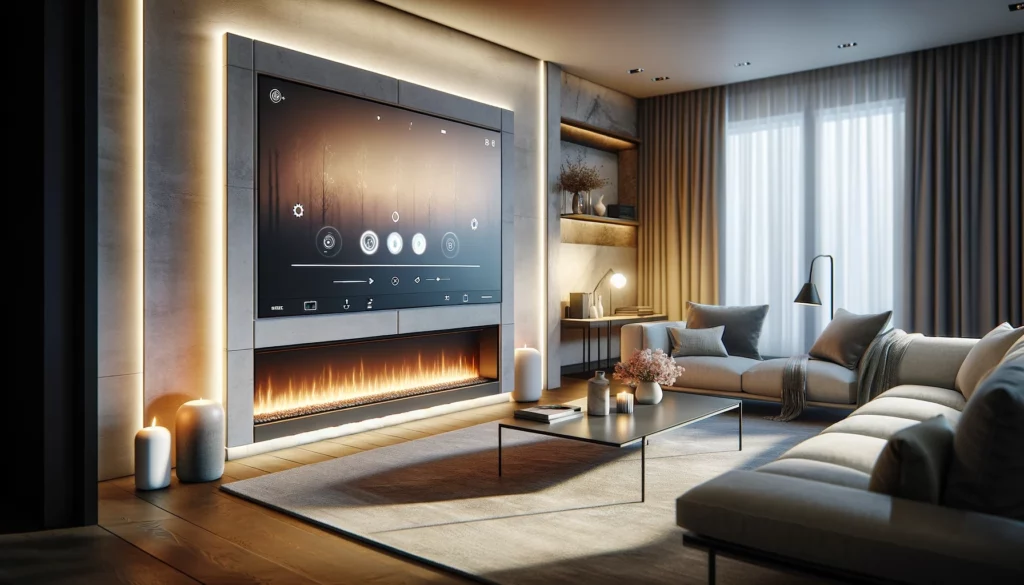
Smart Fireplaces: The Future is Now
The integration of technology in fireplace designs is a growing trend, reflecting the increasing demand for convenience and smart home integration. In 2024, smart fireplaces are becoming more prevalent, offering advanced features that enhance user experience and functionality.
The Emergence of Smart Fireplace Technology
Smart fireplaces represent the intersection of traditional comfort with modern technology. These fireplaces can be controlled remotely via smartphone apps, voice commands through smart home assistants, or even programmable timers. This technological integration caters to the contemporary lifestyle, where ease of use, efficiency, and connectivity are highly valued.
The appeal of smart fireplaces lies in their ability to provide a tailored experience. Users can adjust the heat output, flame intensity, and even the color of the flames with just a few taps on their smartphone or simple voice commands. This level of control and customization enhances the overall enjoyment and functionality of the fireplace.
Key Features of Smart Fireplaces
One of the defining features of smart fireplaces is their remote operability. This allows users to turn the fireplace on or off, adjust settings, and even schedule heating times without being physically present. It’s particularly convenient for pre-heating the home before arrival or ensuring the fire is safely turned off after leaving.
Another significant feature is energy efficiency. Many smart fireplaces are designed to optimize fuel usage and heat distribution, reducing energy consumption and costs. This is particularly appealing in an era of environmental consciousness and sustainability.
Choosing and Integrating Smart Fireplaces
When selecting a smart fireplace, compatibility with existing smart home systems is crucial. It’s important to ensure that the fireplace can seamlessly integrate with other devices and platforms in the home for a cohesive smart home experience.
Design-wise, smart fireplaces come in various styles, from traditional to contemporary, ensuring they can fit into any interior design scheme. The technology is often discreetly integrated, maintaining the aesthetic appeal of the fireplace while offering the added benefits of smart functionality.
Innovative Applications in Smart Fireplace Design
Innovative applications in smart fireplace design are not limited to remote operation. Some models offer features like sound effects that mimic crackling wood, adding to the ambiance. Others come with integrated safety sensors that automatically shut off the fireplace in case of issues, enhancing safety and peace of mind.
The development of smart fireplaces is also seeing a rise in eco-friendly options. Electric smart fireplaces, for instance, offer a flame effect without actual combustion, providing the ambiance of a traditional fireplace without emissions, making them suitable for urban apartments and environmentally conscious users.
Smart fireplaces are redefining the traditional fireplace experience, merging the warmth and coziness of a fire with the convenience and customization offered by modern technology. This trend is a perfect example of how interior design can adapt to incorporate technological advancements, offering both aesthetic appeal and enhanced functionality.
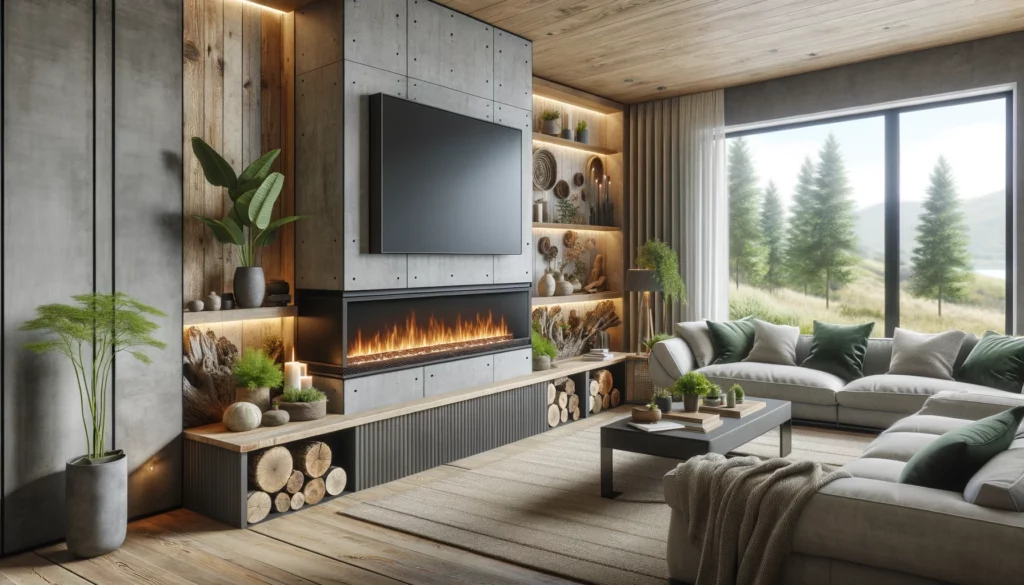
Eco-Friendly Fireplaces: A Sustainable Choice
In an era where environmental impact is a significant concern, the demand for eco-friendly fireplace options is on the rise. For 2024, the focus will be on designs that not only add aesthetic value to spaces but also align with sustainable practices, minimizing the carbon footprint of home heating.
The Growing Importance of Eco-Friendly Designs
Eco-friendly fireplaces are becoming a crucial part of sustainable interior design. As awareness about environmental issues like global warming and air pollution increases, homeowners and designers are seeking heating solutions that are both efficient and responsible. These fireplaces are designed to reduce emissions and use renewable or less polluting fuel sources, making them a more environmentally friendly choice compared to traditional wood-burning or gas fireplaces.
This trend is not just about reducing the environmental impact but also about embracing a lifestyle that values sustainability. Eco-friendly fireplaces can be a key element in homes that aim for a smaller ecological footprint, without sacrificing comfort or style.
Types of Eco-Friendly Fireplaces
Electric fireplaces are a popular eco-friendly option, as they produce heat without combustion, meaning no emissions and better air quality indoors. They are also highly efficient, converting almost all the energy they use into heat, and can be powered by renewable energy sources like solar panels.
Another option is ethanol fireplaces, which burn clean and are free from smoke, soot, and ash. Ethanol, a renewable biofuel, burns very cleanly compared to wood or gas, making it a more environmentally friendly choice.
Pellet stoves are also gaining popularity. They burn compressed wood or biomass pellets, which are considered more sustainable than traditional wood logs. Pellet stoves are known for their efficiency and can be a great eco-friendly alternative for those who prefer the aesthetic of a real flame.
Incorporating Eco-Friendly Fireplaces in Design
When integrating eco-friendly fireplaces into a design, it’s important to consider the overall sustainability of the space. Materials used for the surround and mantel, for instance, can be sourced from recycled or sustainably harvested sources.
The design of the fireplace itself can also reflect an eco-friendly ethos. For example, minimalist designs that use less material can be a more sustainable choice, and integrating natural elements like stone or reclaimed wood can add to the eco-friendly appeal.
Innovative Features and Technologies
Eco-friendly fireplaces are often equipped with innovative features that enhance their sustainability. For instance, some electric fireplaces come with energy-saving modes that reduce power consumption when full heating isn’t necessary. Smart controls can also be used to optimize energy usage, turning the fireplace on or off based on room occupancy or time of day.
Some eco-friendly fireplaces are designed to work in tandem with home heating systems, distributing heat more evenly and efficiently throughout the home. This not only maximizes the heat output but also reduces the overall energy consumption of the household.
Eco-friendly fireplaces represent a shift towards more responsible and sustainable interior design choices. By incorporating these options, designers can offer solutions that are not only beautiful and functional but also align with the growing desire for a more sustainable and environmentally friendly lifestyle.
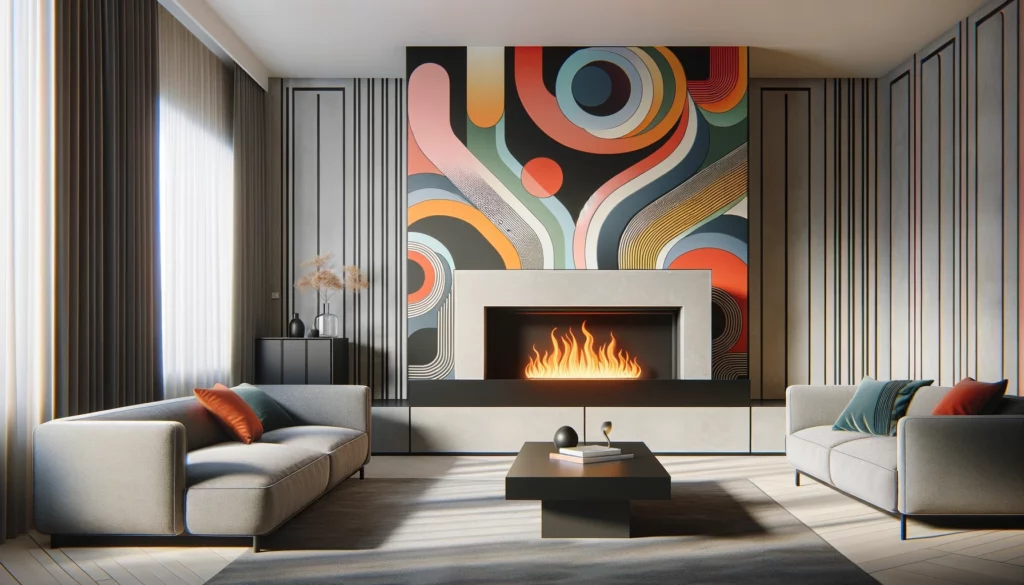
Wallpaper Surrounds: A Blend of Tradition and Modernity
The use of wallpaper for fireplace surrounds is an emerging trend that beautifully marries traditional and modern design elements. This approach is gaining popularity for its ability to add texture, color, and personality to fireplace designs in a distinctive way.
The Revival of Wallpaper in Fireplace Design
Wallpaper surrounds bring a novel and artistic dimension to fireplaces. This trend is a departure from conventional materials like stone or tile, offering a fresh and creative way to enhance the fireplace area. Wallpapers come in an endless variety of patterns, colors, and textures, allowing for a high degree of customization and personalization in fireplace design.
This approach is particularly appealing for those looking to make a unique design statement. Whether it’s a bold, graphic print to create a contemporary focal point or a delicate, vintage pattern for a touch of classic elegance, wallpaper can dramatically transform the look and feel of a fireplace.
Versatility in Styles
One of the strengths of using wallpaper for fireplace surrounds is its versatility. For modern interiors, geometric patterns or abstract designs can add a touch of sophistication and edge. In more traditional settings, floral patterns, paisleys, or even textured wallpapers that mimic materials like wood or stone can complement the overall decor.
This versatility extends to various interior themes as well, from minimalistic and Scandinavian to maximalist and eclectic. Wallpaper can be a unifying element that ties together different aspects of a room’s decor or a contrasting accent that stands out and catches the eye.
Tips for Selecting and Implementing Wallpaper Surrounds
When choosing wallpaper for a fireplace surround, it’s important to consider the scale of the pattern in relation to the room. Larger patterns can make a bold statement in spacious rooms, while smaller patterns might be more suitable for compact spaces.
Durability and safety are also key considerations. It’s essential to select wallpapers that are heat resistant and suitable for use near a heat source. Professional installation is recommended to ensure that the wallpaper adheres properly and remains in good condition over time.
Innovative Applications and Combinations
Wallpaper surrounds offer a canvas for creativity. Designers can experiment with layering textures and colors, or even combining different wallpaper patterns for a truly bespoke look. For a more subtle approach, a textured wallpaper in a neutral tone can add depth and interest without overpowering the space.
Incorporating other design elements, such as wood trim or metal accents, can enhance the fireplace surround and create a more cohesive look. This mix-and-match approach allows for endless possibilities, blending tradition and modernity in exciting and unexpected ways.
Wallpaper surrounds represent a fusion of artistic expression and interior design innovation. This trend not only provides a unique way to personalize a fireplace but also showcases how traditional materials can be reimagined to suit contemporary tastes and styles. By embracing wallpaper surrounds, designers can offer clients a versatile and striking option that adds character and charm to any living space.
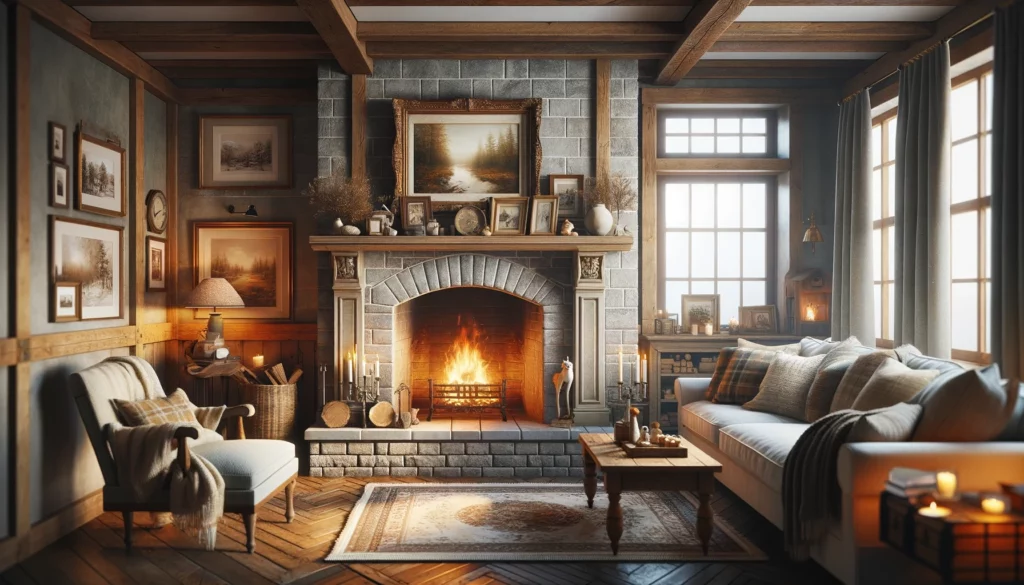
Final Thoughts
The array of fireplace design trends for 2024 showcases a dynamic blend of style, functionality, and innovation. From the elegance of natural stones and the sleek appeal of minimalist designs to the vibrant energy of colorful surrounds and the classic charm of vintage styles, these trends provide a rich spectrum for interior designers to create unique and inviting spaces. Eco-friendly options and smart technology further enhance the versatility, allowing for designs that are not only aesthetically pleasing but also environmentally conscious and technologically advanced.
For interior designers, embracing these trends means unlocking new potentials in creating living spaces that are both functional and reflective of personal style. Whether it’s adding a touch of luxury, a hint of nostalgia, or a splash of color, the right fireplace can transform any room into a cozy, stylish haven. These trends are an invitation to explore, innovate, and personalize, ensuring that each design not only meets but exceeds the expectations of modern living spaces.